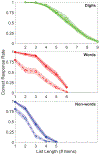Interactions Between Item Set and Vocoding in Serial Recall
- PMID: 31033634
- PMCID: PMC6776730
- DOI: 10.1097/AUD.0000000000000718
Interactions Between Item Set and Vocoding in Serial Recall
Abstract
Objectives: Serial recall of digits is frequently used to measure short-term memory span in various listening conditions. However, the use of digits may mask the effect of low quality auditory input. Digits have high frequency and are phonologically distinct relative to one another, so they should be easy to identify even with low quality auditory input. In contrast, larger item sets reduce listener ability to strategically constrain their expectations, which should reduce identification accuracy and increase the time and/or cognitive resources needed for identification when auditory quality is low. This diminished accuracy and increased cognitive load should interfere with memory for sequences of items drawn from large sets. The goal of this work was to determine whether this predicted interaction between auditory quality and stimulus set in short-term memory exists, and if so, whether this interaction is associated with processing speed, vocabulary, or attention.
Design: We compared immediate serial recall within young adults with normal hearing across unprocessed and vocoded listening conditions for multiple stimulus sets. Stimulus sets were lists of digits (1 to 9), consonant-vowel-consonant (CVC) words (chosen from a list of 60 words), and CVC nonwords (chosen from a list of 50 nonwords). Stimuli were unprocessed or vocoded with an eight-channel noise vocoder. To support interpretation of responses, words and nonwords were selected to minimize inclusion of multiple phonemes from within a confusion cluster. We also measured receptive vocabulary (Peabody Picture Vocabulary Test [PPVT-4]), sustained attention (test of variables of attention [TOVA]), and repetition speed for individual items from each stimulus set under both listening conditions.
Results: Vocoding stimuli had no impact on serial recall of digits, but reduced memory span for words and nonwords. This reduction in memory span was attributed to an increase in phonological confusions for nonwords. However, memory span for vocoded word lists remained reduced even after accounting for common phonetic confusions, indicating that lexical status played an additional role across listening conditions. Principal components analysis found two components that explained 84% of the variance in memory span across conditions. Component one had similar load across all conditions, indicating that participants had an underlying memory capacity, which was common to all conditions. Component two was loaded by performance in the vocoded word and nonword conditions, representing the sensitivity of memory span to vocoding of these stimuli. The order in which participants completed listening conditions had a small effect on memory span that could not account for the effect of listening condition. Repetition speed was fastest for digits, slower for words, and slowest for nonwords. On average, vocoding slowed repetition speed for all stimuli, but repetition speed was not predictive of individual memory span. Vocabulary and attention showed no correlation with memory span.
Conclusions: Our results replicated previous findings that low quality auditory input can impair short-term memory, and demonstrated that this impairment is sensitive to stimulus set. Using multiple stimulus sets in degraded listening conditions can isolate memory capacity (in digit span) from impaired item identification (in word and nonword span), which may help characterize the relationship between memory and speech recognition in difficult listening conditions.
Figures







References
-
- Allen B, Becker M (2015). Learning alternations from surface forms with sublexical phonology. Lingbuzz, Retrieved from http://ling.auf.net/lingbuzz/002503
-
- Barrouillet P, Bernardin S, Camos V (2004). Time Constraints and Resource Sharing in Adults’ Working Memory Spans. J Exp Psychol Gen, 133, 83–100. - PubMed
Publication types
MeSH terms
Grants and funding
LinkOut - more resources
Full Text Sources

